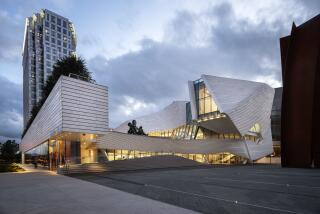A new era for ancient art at the Metropolitan
NEW YORK — The original plan for the south galleries at the Metropolitan Museum of Art was to make them the home for the museum’s Greek and Roman holdings. Somewhere along the way that changed, and by 1954 much of that space was turned into a restaurant.
But now, after a 15-year, $220-million project, it’s again all about the art. The museum’s new Greek and Roman galleries -- centered on a two-story skylighted hall that evokes a Roman public space -- opened to the public Friday.
Philippe de Montebello, the museum’s director, called the opening “a truly defining moment.”
With the galleries once again home to ancient statues, bronze sculptures and even an Etruscan chariot, visitors will get a glimpse of history in a logical order -- from the north end, which houses Egyptian art, to the new spaces in the south end spanning from the Bronze Age through the reign of Constantine, said Carlos Picon, curator in charge of the Greek and Roman art department.
“It was the original intention for it to be a chronological sweep through millennia,” he said. “It’s exciting to be able to think of the crowds that will come in and for the first time get a complete view of the entire classical world, beginning to end.”
The newly renovated galleries cover a period from about the 4th century B.C. to the 4th century A.D. and bring thousands of pieces of the museum’s collection out of storage.
The centerpiece of the new galleries is a grand space that even on a rainy day is bathed in light. In its original iteration, the gallery’s skylight roof was only one story up; for the new version, the roof has been raised an additional story. Columns line the atrium, with a black fountain in the center.
Statues and sculptures in the court include mythological figures such as Hercules and historical images of rulers such as Caligula. Around the main court are smaller galleries, covering southern Italian art and Hellenistic and later Roman Empire artifacts.
More to Read
The biggest entertainment stories
Get our big stories about Hollywood, film, television, music, arts, culture and more right in your inbox as soon as they publish.
You may occasionally receive promotional content from the Los Angeles Times.










